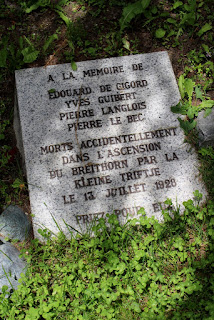Kimmie hooked me up with a 42 franc train ticket to anywhere in Switzerland so I decided to go to Zermatt so I can see the iconic Matterhorn. It isn't listed on the board, which of course makes one a little nervous, but they do stop in Visp (just before Brig) before transferring trains to Zermatt. Visp is a German speaking Swiss town so just before arrival the announcements switched from French first to German first. It is a little thing that one notices when they have nothing else to notice.
As the train went around the other side of Lac Léman I caught a glimpse of Château de Chillon. Built around 1000AD, used as a prison in the 16th century, and easily accessible, it is one of the most visited castles in Switzerland.
Almost four hours later I arrived in Zermatt. Zermatt is a German speaking town as well, so I got to enjoy German baked goods, and practice my German. I speak German like a speak French, I shake my head vigorously with a worried look on my face forgetting that I speak any language. It usually does the trick.
I actually went to the bakery twice in one day, for lunch and for dinner.
The pretzel here was the best pretzel I have ever had in my life. A thin, hard crust, soft on the inside, hot from the oven...
Zermatt sits at the base of the Matterhorn.
It has a population of 5,800.
There are several cemeteries around town which memorialize those who have attempted to summit Matterhorn, or nearby peaks. Many of the gravestones describe how they died, who they were with, and the peak they were on. Although the gender and age varies many (starting in 1865 after the first ascent) are males in their twenties. There is an average of 12 deaths per year.
I do wonder if climbers/mountaineers go to the cemetery before or after a planned summit.
Zermatt is cool but I was anxious to take the Gornergrat Bahn to the top so after an hour I took the train which climbs 1,500 meters in thirty minutes (for 90 francs round trip... pricey, especially considering that a flight to Europe is the same as 13 train rides on the Gornergrat Bahn).
Gorner glacier (Gornergletscher in German) is spectacular. Although it has lost more than 2,500 meters in distance over the past 150 years, it is still massive- 12 km long by 1 km wide.
Who would have guessed that in the alps ibex, marmots, crows and aluminum cans are friends.
A perfect place for a cappuccino.
I waited patiently for the Matterhorn (directly behind me) to show its face but the coward never did.
I decided to walk from the top to the next train station below. It was nice to hike a little since most of day was spent in sitting in trains (9 hours in total, but the sun doesn't set until 10pm so there are more hours in day).
Back in town I walked straight onto a movie set!
I am kidding but it did feel that way.
You have heard of Swiss cheese but never Swiss hams.
These musicians were characters, every time someone stopped to take a picture they stopped to pose.
Right before my train departed they started playing right in the middle of town. Maybe the alphorn will be my next instrument, it is even more of a conversation starter than a banjo.










































































